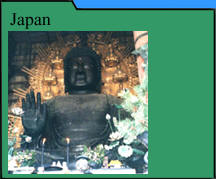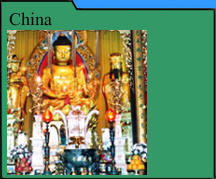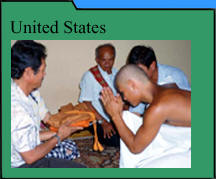back to Gallery
Mainpage
Buddhism
Buddhism was founded
about 2500 years ago by Siddhartha Gautama in a region of what
is now India and Nepal. He was a prince, but he renounced the
comforts of princely life in order to seek insight into the cause
of human suffering and how to overcome it. Finally, in meditation,
he woke up to the true nature of himself and the universe. Siddhartha
became known as the Buddha, which means, the enlightened or awakened
one. He dedicated himself to teach others what he found: that
the cause of human suffering is excessive desire and attachment
and that one must break the shackles of deluded thinking, anger,
and aversion in order to become free of this suffering and realize
one's true nature.
Since that time, many schools
of Buddhism have developed in South and East Asia and have transmitted
throughout the world. They include various forms of teaching,
ritual, and spiritual practice, but all hark back to this original
insight. In a sense, all Buddhist schools are like universal social
welfare institutions: they are dedicated to help human beings
and all other beings to find enlightenment and relief from suffering.
In this section of the Gallery,
you will find images that relate to Buddhism in East Asia and
the United States. Most of the images are from South Korea, Japan,
and Hong Kong. Many are full of rich color, intricate designs,
and significant iconography. The images indicate various cultural
nuances. Some also show influence from other traditions like Taoism
and shamanism. Buddhists often teach that religious images and
teachings are meant to direct and encourage practitioners in pursuing
the path to enlightenment, as the Buddha did, and not to become
stuck in them.
Of particular note are images of
Bodhisattvas, who are described in the Mahayana (Great Vehicle)
branch of Buddhism as beings who have awakened to their true nature
but retain existence in order to help other beings on their journey
to enlightenment. For example, Avalokiteshvara Bodhisattva (Sanskrit;
also known as Kwan Yin, Chinese; Kannon, Japanese; Kwanum, Korean)
expresses compassionate help to all beings. Sometimes Kwan Yin
is depicted with eleven heads and a thousand eyes and hands, perceiving
and reaching out to help all beings. Another popular Bodhisattva
is Kshitigarbha (Sanskrit; also known as Ti ts'ang, Chinese; Jizo,
Japanese; Jijang, Korean) who helps beings deal with the death
transition time and other periods of crisis. For some believers,
these beings are understood as actual entities who can be beseeched
for help. For others, they are metaphors of qualities inherent
in everyone's true nature of wisdom and compassion. Or, they may
be both.



